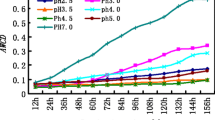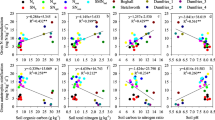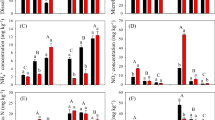Abstract
Our aim was to test the effects of simulated acid rain (SAR) at different pHs, when applied to fertilized and unfertilized soils, on the leaching of soil cations (K, Ca, Mg, Na) and Al. Their effects on soil pH, exchangeable H+ and Al3+ and microbial community structure were also determined. A Paleudalfs soil was incubated for 30 days, with and without an initial application of urea (200 mg N kg−1soil) as nitrogen (N) fertilizer. The soil was held in columns and leached with SAR at three pH levels. Six treatments were tested: SAR of pH 2.5, 4.0 and 5.6 leaching on unfertilized soil (T1, T2 and T3), and on soils fertilized with urea (T4, T5 and T6). Increasing acid inputs proportionally increased cation leaching in both unfertilized and fertilized soils. Urea application increased the initial Ca and Mg leaching, but had no effect on the total concentrations of Ca, Mg and K leached. There was no significant difference for the amount of Na leached between the different treatments. The SAR pH and urea application had significant effects on soil pH, exchangeable H+ and Al3+. Urea application, SAR treated with various pH, and the interactions between them all had significant impacts on total phospholipid fatty acids (PLFAs). The highest concentration of total PLFAs occurred in fertilized soils with SAR pH5.6 and the lowest in soils leached with the lowest SAR pH. Soils pretreated with urea then leached with SARs of pH 4.0 and 5.6 had larger total PLFA concentrations than soil without urea. Bacterial, fungal, actinomycete, Gram-negative and Gram-positive bacterial PLFAs had generally similar trends to total PLFAs.





Similar content being viewed by others
References
Baath E, Anderson TH (2003) Comparison of soil fungal/bacterial ratios in a pH gradient using physiological and PLFA-based techniques. Soil Biol Biochem 35:955–963
Barak P, Jobe BO, Krueger AR, Peterson LA, Laird DA (1997) Effects of long-term soil acidification due to nitrogen fertilizer inputs in Wisconsin. Plant Soil 197:61–69
Belay A, Claassens AS, Wehner FC (2002) Effect of direct nitrogen and potassium and residual phosphorus fertilizers on soil chemical properties, microbial components and maize yield under long-term crop rotation. Biol Fertil Soils 35:420–427
Bohan L, Seip HM, Larssen T (1997) Response of two Chinese forest soils to acidic inputs: leaching experiment. Geoderma 75:53–73
Conyers MK, Tang C, Poile G, Liu DL, Chen D, Nuruzzaman Z (2011) Combination of biological activity and the nitrate form of nitrogen can be used to ameliorate subsurface soil acidity under dryland wheat farming. Plant Soil 348:155–166
Guicharnaud R, Paton GI (2006) An evaluation of acid deposition on cation leaching and weathering rates of an Andosol and a Cambisol. J Geochem Explor 88:279–283
Guo JH, Liu XJ, Zhang Y, Shen JL, Han WX, Zhang WF, Christie P, Goulding KW, Vitousek PM, Zhang FS (2010) Significant acidification in major Chinese croplands. Science 327:1008–1010
Hamer U, Potthast K, Makeschin F (2009) Urea fertilisation affected soil organic matter dynamics and microbial community structure in pasture soils of Southern Ecuador. Appl Soil Ecol 43:226–233
Jia JX, Li ZP, Liu M, Che YP (2010) Effect of nitrogen fertilizer on nitrification of paddy red soil with different fertility. J Ecol Rural Environ 26(4):329–333 (in Chinese)
Jr Abreu CH, Muraoka T, Lavorante AF (2003) Exchangeable aluminum evaluation in acid soils. Sci Agric 60:543–548
Juo A, Dabiri A, Franzluebbers K (1995) Acidification of a kaolinific alfisol under continuous cropping with nitrogen-fertilization in West Africa. Plant Soil 171:245–253
King HB, Wang MK, Zhuang SY, Hwong JL, Liu CP, Kang MJ (2006) Sorption of sulfate and retention of cations in forest soils of Lien-Hua-Chi watershed in central Taiwan. Geoderma 131:143–153
Larssen T, Vogt RD, Seip HM, Furuberg G, Liao BH, Xiao JS, Xiong JL (1999) Mechanisms for aluminum release in Chinese acid forest soils. Geoderma 91:65–86
Li Z (1999) The acidity and chemical characteristics of precipitation in Zhejiang Province. China Environ Sci 5:436–440
Ling DJ, Zhang JE, Ouyang Y, Huang QC (2007) Role of simulated acid rain on cations, phosphorus, and organic matter dynamics in latosol. Arch Environ Contam Toxicol 52:16–21
Liu L, Song CY, Yan ZG, Li FS (2009) Characterizing the release of different composition of dissolved organic matter in soil under acid rain leaching using three-dimensional excitation–emission matrix spectroscopy. Chemosphere 77:15–21
Lu RK, Shi ZY, Lai XW (1995) Nutrient degradation characteristics in red soil (II)—conversion of urea and ammonium bicarbonate in the red soil. Chin J Soil Sci 26(6):241–243 (in Chinese)
Malhi SS, Harapiak JT, Nyborg M, Gill KS (2000) Effects of long-term applications of various nitrogen sources on chemical soil properties and composition of bromegrass hay. J Plant Nutr 23:903–912
Montecchiaa MS, Correaa OS, Soriaa MA, Freyb SD, Garciaa AF, Garlandc JL (2011) Multivariate approach to characterizing soil microbial communities in pristine and agricultural sites in Northwest Argentina. Appl Soil Ecol 47:176–183
Pennanen T, Fritze H, Vanhala P, Kiikkila O, Neuvonen S, Baath E (1998) Structure of a microbial community in soil after prolonged addition of low levels of simulated acid rain. Appl Environ Microb 64:2173–2180
Rodhe H, Dentener F, Schulz M (2002) The global distribution of acidifying wet deposition. Environ Sci Technol 36:4382–4388
Rosseland BO (1990) Environmental effects of aluminium. Environ Geochem Health 12:17–27
Russell AELD (2006) Nitrogen fertilization and cropping system impacts on soil quality in Midwestern Mollisols. Soil Sci Soc Am J 1:249–255
Tjalf B, Neslihan T, Martin B, Erwin T, Wilfred R, Dick R (2012) The influence of long-term copper contaminated agricultural soil at different pH levels on microbial communities and Springtail transcriptional regulation. Environ Sci Technol 46:60–80
Vieira RP, Gonzalez AM, Cardoso AM, Oliverira DN, Albano RM, Clementino MM, Martins OB, Paranhos R (2008) Relationships between bacterial diversity and environmental variables in a tropical marine environment, Rio de Janeiro. Environ Microbiol 10:189–199
Walna B, Drzymala S, Siepak J (1998) The impact of acid rain on calcium and magnesium status in typical soils of the Wielkopolski National Park. Sci Total Environ 220:115–120
Wu YP, Ding N, Wang G, Xu JM, Wu JJ, Brookes PC (2009) Effects of different soil weights, storage times and extraction methods on soil phospholipid fatty acid analyses. Geoderma 150:171–178
Xu RK, Coventry DR, Farhoodi A, Schultz JE (2002) Soil acidification as influenced by crop rotations, stubble management, and application of nitrogenous fertiliser, Tarlee, South Australia. Aust J Soil Res 40:483–496
Ying JY, Zhang LM, Wei WX, He JZ (2013) Effects of land utilization patterns on soil microbial communities in an acid red soil based on DNA and PLFA analyses. J Soil Sediment 13:1223–1231
Zhang JE, Ouyang Y, Ling DJ (2007) Impacts of simulated acid rain on cation leaching from the Latosol in south China. Chemosphere 67:2131–2137
Zhang HM, Wang BR, Xu MG (2008a) Effects of inorganic fertilizer inputs on grain yields and soil properties in a long-term wheat–corn cropping system in south China. Commun Soil Sci Plan 39:1583–1599
Zhang NL, Wan SQ, Li LH, Bi J, Zhao MM, Ma KP (2008b) Impacts of urea N addition on soil microbial community in a semi-arid temperate steppe in northern China. Plant Soil 311:19–28
Zhou J, Xia F, Liu XM, He Y, Xu JM, Brookes PC (2013) Effects of nitrogen fertilizer on the acidification of two typical acid soils in South China. J Soil Sediment. doi:10.1007/s11368-013-0695-1
Acknowledgments
This work was financially supported by the National Basic Research Program of China (2011CB100502) and the Fundamental Research Funds for the Central Universities.
Author information
Authors and Affiliations
Corresponding author
Additional information
Responsible editor: Zhihong Xu
Rights and permissions
About this article
Cite this article
Liu, X., Zhou, J., Li, W. et al. The combined effects of urea application and simulated acid rain on soil acidification and microbial community structure. Environ Sci Pollut Res 21, 6623–6631 (2014). https://doi.org/10.1007/s11356-014-2573-9
Received:
Accepted:
Published:
Issue Date:
DOI: https://doi.org/10.1007/s11356-014-2573-9




